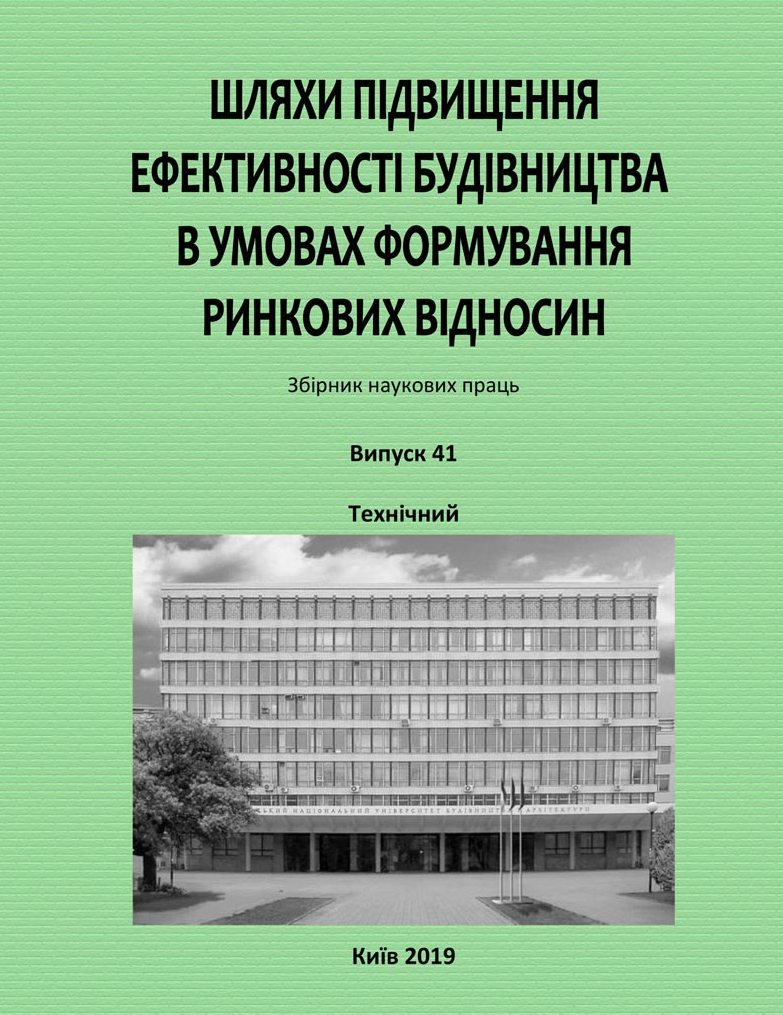The forming of the tool sets for the compulsory methods of installation of low-rise wireframe buildings
DOI:
https://doi.org/10.32347/2707-501x.2019.41.12-18Keywords:
installation, module limiter, module latch equipment, labor costs, orientation, landing, reconciliation, fixed, samofiksatsiyaAbstract
In the article on the basis of the received data the final decision is made concerning the variant of modules of limiters and retainers for the further formation of sets of mounting equipment for forced landing, alignment and fixing of structures of frames of low-rise buildings.
The formation of rational kits for mounting equipment for forced methods of mounting frames of low-rise buildings involves the implementation of operations of two algorithms, namely: the first – for. justification and choice of parameters of the restraint modules and locking modules; the second – for the formation of tooling kits for forced landing, alignment and fixing of structures.
Based on the data obtained by the first algorithm, a final decision is made regarding the variant of the restraint modules and retainers for the further formation of mounting equipment kits for the forced landing, alignment and fixing of the structures of the frames of buildings. This algorithm involves nine operations: analysis of the output data, based on the accepted butt joints and design parameters determine the parameters of the gaps, the designation of technological tolerance for deviation of the upper cross section of the mounted structures from the vertical axis, determine the accuracy parameters of the modules of the limiters and locks outside the corners possible deviation of the system structure-support and polispast-structure, the decision on the design of modules of limiters and clamps, formation of arrangements oduliv constraints and posture, calculation of network models, evaluation and justification of decisions.
For the formation of rational kits of rigging, based on the methodology of priority setting, an original second algorithm was developed, which allows to identify the most effective variants depending on the parameters of frames, structures, from butt joints, taking into account the normative functional and technological tolerances. The basis for drawing up the variants is the schematics of installation with a certain sequence of mounting of the frames and the sets of mounting accessories.
References
Kagramanov, R. A. & Machabeli, Sh. L. (1987) Montazh konstrukcij sbornyh mnogoetazhnyh grazhdanskih i promyshlennyh zdanij: sprav. – M.: Strojizdat.
Telichenko, V. I., Terentev, O.M. & Lapidus, A. A. (2005) Tehnologiya stroitelnyh processov: v 2 ch. Ch 1.: Ucheb. dlya stroit. Vuzov 2-e izd., ispr. I dop. – M.: Vyssh. shk.
Ammosov, N.G. (1974). Montazh stroitelnyh konstrukcij: / ucheb. posobie dlya vuzov / N. G. Ammosov. – M.: Vysshaya shkola.
Nesushie i ograzhdayushie konstrukcii. SNiP 3.03.01-87. (1996)– M.: GUP CPP.
Sistema zabezpechennya tochnosti geometrichnih parametriv u budivnictvi. Vikonannya vimiryuvan, rozrahunok ta kontrol tochnosti geometrichnih parametriv. DSTU – N B V.1.3-1:2009 (2010) / DP «Ukrarhbudinform»: Minregionbud Ukrayini.
Instrukciya po raschetu i kontrolyu tochnosti sbornyh stroitelnyh konstrukcij nazemnyh sooruzhenij. (VSN-2-22-71).(1972). - M., Mingazprom.
Tonkacheyev, G.M. & Lepska, L.A. (2012). Formuvannya i vibir moduliv tehnologichnoyi osnastki dlya posadki i fiksaciyi zbirnih budivelnih konstrukcij. Tehnologiya, organizaciya, mehanizaciya ta geodezichne zabezpechennya budivnictva: zb. nauk. pr. Visnik DonNABA. 6 (98). 33–40.
Tonkacheyev, G.M., Lepska, L.A. & Sharapa, S.P. (2014). Sistema obgruntuvannya tehnologichnih parametriv montazhnoyi osnastki dlya obmezhennya ta fiksaciyi konstrukcij, sho montuyutsya. Mistobuduvannya ta teritorialne planuvannya. 52, 418-426.
Downloads
How to Cite
Issue
Section
License
Copyright (c) 2020 L. Leps’ka

This work is licensed under a Creative Commons Attribution 4.0 International License.
Authors who publish with this journal agree to the following terms:
- Authors retain copyright and grant the journal right of first publication with the work simultaneously licensed under a Creative Commons Attribution License that allows others to share the work with an acknowledgement of the work's authorship and initial publication in this journal.
- Authors are able to enter into separate, additional contractual arrangements for the non-exclusive distribution of the journal's published version of the work (e.g., post it to an institutional repository or publish it in a book), with an acknowledgement of its initial publication in this journal.
- Authors are permitted and encouraged to post their work online (e.g., in institutional repositories or on their website) prior to and during the submission process, as it can lead to productive exchanges, as well as earlier and greater citation of published work (See The Effect of Open Access).

